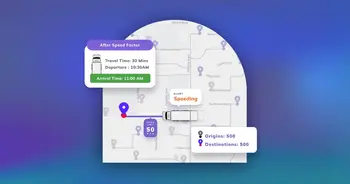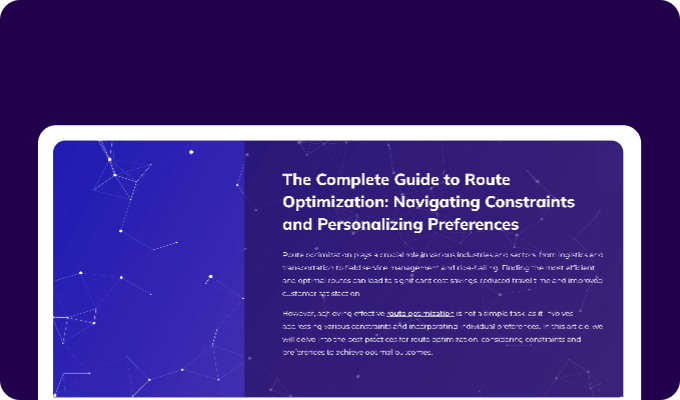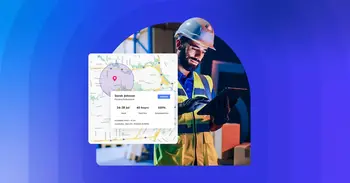What is a Point of Interest (POI)?
A Point of Interest (POI) is a specific location of interest or importance to a particular group. In the context of last-mile delivery, a POI is typically a destination where goods such as a store, a warehouse, a customer’s home or office, or a pickup/dropoff point need to be delivered.
POIs are important for last-mile delivery vehicles because they help optimize delivery routes and improve the efficiency of delivery operations. By using POIs to plan delivery routes, drivers can ensure they take the shortest and most efficient paths to deliver goods. This can help reduce travel time, fuel costs, and vehicle wear and tear, ultimately resulting in cost savings for the delivery company.
Moreover, POIs can also help ensure that deliveries are made on time and to the correct location. Delivery drivers can use POI data to navigate accurately to each destination, reducing the likelihood of missed deliveries, incorrect deliveries, or delays due to getting lost.
Your Point of Interests (POIs) are more than just latitudes and longitudes.
For companies that rely heavily on maps and navigation — such as deliveries, ride-hailing, ecommerce, and logistics, inaccurate or improperly configured maps can be a massive cash-drain.

Over 71% of drivers spend anywhere from 4 to 10+ minutes trying to find the exact drop-off location. This aside, over 95% of drivers have faced problems with inaccurate mapping — it’s estimated that the logistics industry could save $2.6 billion annually with better maps.
With last-mile delivery accounting for 53% of the shipping cost, this number becomes even more significant.
Before we can fix it, we need to dive deeper into the challenge itself.
For doorstep navigation, your destinations are harder to reach than just a pinpoint on the map — this is because there’s a huge difference between knowing where a place is versus knowing how to reach it.
As an example, let’s take The Plaza in New York — your mapping solution will (or at least should) include the exact location of the reception area as a rooftop POI — and that’s simply not enough.

The route you take is determined by a variety of factors — such as the type of vehicle you’re in, the purpose of your visit and more.
- For example, as a hotel guest, you’ll enter the building through the main entrance if you’re in a car.
- However, the staff, catering, and housekeeping vendors will use a designated staff entrance instead.
This is where the plot thickens (pardon the pun) — depending on your business, the requirement, and the various entrances and exits involved, each location can have multiple relevant POIs to navigate through.
It’s also why simply plugging in the ever-popular ‘you-know-which’ mapping API isn’t enough. Like most consumer solutions, it simply can’t cater to the nuances an enterprise needs when it comes to mapping POIs.
When you’re a growing business that’s serving customers at scale, the limitations of consumer-oriented maps severely limit the doorstep experience for your customers.
Challenges with inaccurate Point of Interest (POI)?
Before we can fix it, we need to dive deeper into the challenge itself.
For doorstep navigation, your destinations are more complicated to reach than just a pinpoint on the map — this is because there’s a massive difference between knowing where a place is versus knowing how to reach it.
As an example, let’s take The Plaza in New York — your mapping solution will (or at least should) include the exact location of the reception area as a rooftop POI — and that’s simply not enough.
The route you take is determined by a variety of factors — such as the type of vehicle you’re in, the purpose of your visit and more.
- For example, as a hotel guest, you’ll enter the building through the main entrance if you’re in a car.
- However, the staff, catering, and housekeeping vendors will use a designated staff entrance instead.
This is where the plot thickens (pardon the pun!) — depending on your business, the requirement, and the various entrances and exits involved, each location can have multiple relevant POIs to navigate through.
It’s also why simply plugging in the ever-popular ‘you-know-which’ mapping API isn’t enough. Like most consumer solutions, it simply can’t cater to the nuances an enterprise needs when it comes to mapping POIs.
When you’re a growing business that’s serving customers at scale, the limitations of consumer-oriented maps severely limit the doorstep experience for your customers.
Challenges every business face due to incorrect Point of Interest –
Most map APIs follow a one map fits all approach, serving the needs of millions of end customers through singular, consolidated map data. Identifying POIs happens in a similar way — where the goal is to keep it relevant for end customers.
Relying on consumer feedback and data to determine POIs is rarely ideal.
Generic, customer-centric POIs simply don’t provide the data needed by your business’s use case, leading to a series of operational challenges.
These include:
1. Last-mile accuracy

- Finding the right pick-up and drop-off points is probably the biggest grievance shared by both your customers and drivers. This can be especially frustrating at locations with multiple entrances and exits. For example, in a large apartment complex, your agent can end up wasting precious minutes trying to locate the right entry, building, and house.
- Similarly, the POI can change depending on the use case and vehicle. For example, in a mall, customers would come in through the main or parking entrance, while the restocking vehicle and team would enter through the service gate.
2. Information on serviceability restrictions

- These refer to the real-world dynamics that include access restrictions — like which gates of a shopping mall or apartment complex might be open at night. In most cases, these are location-specific and often arbitrary.
- Serviceability conditions can also pose unique challenges, such as specific roads not permitting vehicles to stop for pick-ups or drop-offs.
- Finally, local nuances like one-ways, time-based restrictions, and parking limitations can further impact your operations.
3. Incorrect or insufficient POIs

- POIs relevant to end consumers may not be relevant to you — for example, entry-exit locations for customers vs cargo at an office location.
- Cities are dynamic — landmarks, roads, and POIs can change by as much as 5% each year! These changes can take months to reflect on generic maps due to the customer-centric approach and can hamper your operations severely because your agents can be among the first to drive on these new roads.
- Internal roads such as for a large apartment complex are often missing from public maps. These can be home to POIs that are critical for your business.
3 metrics that giveaway that your POIs need to be fixed

When you need to sift through customer and agent feedback to identify gaps in your user experience, getting to the crux of the problem can be challenging- however, for most map-driven use cases (especially on-demand delivery and ride-hailing), most consumer grievances can be traced back to your maps.
Here are a few metrics that can be a dead giveaway that your POIs need to be fixed:
- Frequently incorrect ETA\ATA or late deliveries: There’s often a direct correlation between the % of late deliveries and the quality of POIs in neighbourhoods where ETA|ATA deviations are abnormally high. That’s because POIs play a crucial role in the last mile navigation and a drop in their accuracy can leave your delivery agents struggling to find the customer’s doorstep.
- Cancellations: Similarly, if there are landmarks or neighbourhoods where cancellations are unexpectedly high, the reason could be poor POIs causing a lousy customer experience. After all, a customer is likely to cancel a cab if the driver seems to be going in the wrong direction.
- Feedback: User feedback from your customers and agents for your orders (even cancelled ones) can give you some valuable insights. If these reasons include high ETAs, again, you can probably trace that back to poor POIs.
If you’re a PM trying to fix ETAs, we have just the thing for you: On-Demand Deliveries and Rides: Effective ETA Strategy
What is custom POIs?

Better POIs can be a game-changer for your growth, but how do you restructure your map layers so you can properly utilize them? How do you gain more granular control over your maps to curate the POIs you need?
For business-specific requirements, customizable hyperlocal maps are a much better fit — with tailored POIs overseen by your team that are built for your business.
How to map Point of Interest (POIs)?
How to Create POIs
Generating your initial set of POIs involves two key steps:
- Getting a set of ‘raw maps’ as a base — such as Open Street Maps or a different mapping vendor
- Overlaying your historical data on this map to generate business-contextual POIs
In this fairly automated process, a mapping AI leverages your historical data and builds custom POIs that respond intuitively to your business.
This can reveal key insights — such as where your agents and drivers park their vehicles in a particular locality, the entrances they use for entry/exit, and more. However, automated overlaying can also add a lot of noise to your map layers.
Curating your POIs
While your past data can be a goldmine of insights, the automated process requires an additional layer of human-in-loop quality control to use in a business context.
The curation step involves quality checks that include:
- Key attribute checks: This ensures that the most critical data about a POI, such as name and category, are found and filled in correctly.
- Fine-grained mapping: This confirms that the POIs are accurately located on a reference map — so that they appear on the right side of a road or within the right building.
- Contextual attributes: These include additional attributes that are relevant to your use case, such as opening/closing hours, storefront photos, which gates are suitable for which vehicle types, and so on.
With these steps, you can leverage blended AI — which uses intelligent automation and human intervention, to ensure that you have an additional layer of POIs that are tailored to your business requirements.
This layer goes a long way in reducing your drivers’ last-mile navigation challenges.
What impact will better POIs have on my growth?

With better-mapped POIs, here’s what you can expect:
- Lower cancellations: A key cause of ride or delivery cancellations is the inability to find pickup/drop-off locations for orders or customers. With higher map accuracy, cancellations invariably go down.
- Faster arrival times: Better POIs mean that the driver can quickly navigate to the location and find the correct entry/exit gates, leading to faster arrival times and shorter on-road duration.
- Smoother delivery and pickup experience: The last leg of the journey often involves a flurry of calls or texts between the driver and customer when they try to find each other. With better POIs, there is less need for repeated interactions and leads to a smoother customer experience.
Accurate POIs have an impact on your business growth and operations — including customer retention, asset utilization, and overall profitability.
Setting up custom POIs to power your business?

At NextBillion.ai, we help you pair the best of AI with mapping experts, helping you build and maintain a customizable layer of accurate POIs.
We also power:
- Precise geocoding that’s optimized for deliveries, ride-hailing, and logistics which deals well with unstructured data
- Search and Autocomplete APIs with multi-language support, typo tolerance, and customizable ranking and relevance
To learn more about improving your ETAs, download our whitepaper on Custom Map Stack.




